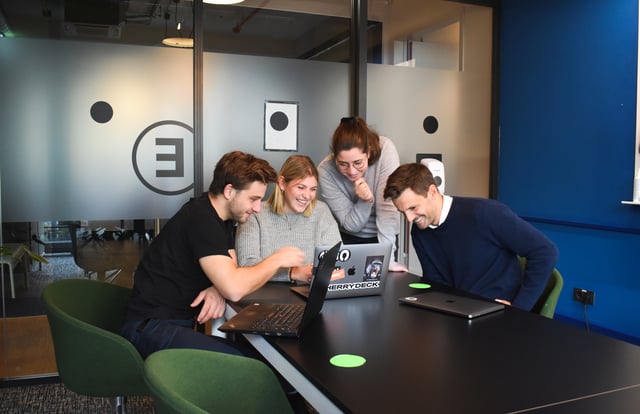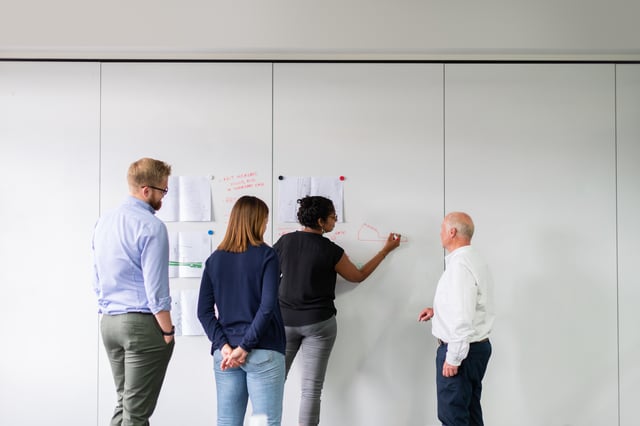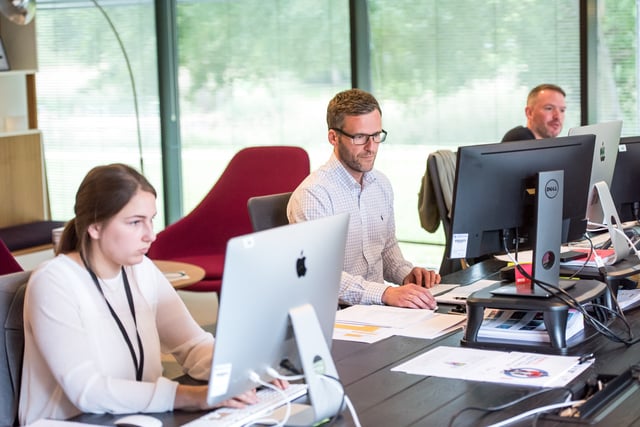How Airbus Created a Successful Innovation Management Program
Introduction
Airbus is one of the world‘s foremost aerospace companies, with 133,000 employees, manufacturing sites in France, Germany, Spain, the UK, the US, and China, and revenues of 58.76 billion EUR (2022).
In 2010, Tom Enders, Airbus CEO at the time, initiated efforts to enhance and structure the company’s innovation activities through an end-to-end innovation process. This led to the creation of the Airbus Innovation Team, dedicated to fueling the innovation engine with ideas, deploying an efficient process, and delivering results through innovation.
Here, we explore the steps Airbus took on its journey to create a highly successful innovation management program.
Subscribe to the HYPE Innovation Blog
It all starts with defining your innovation goals
The Airbus Innovation Team recognized the importance of developing an open innovation platform for all employees to engage in collaboration and idea sharing. This platform became the digital space for innovation management and helped to promote the spirit of innovation across the organization.
Like many large organizations, document and knowledge management tools such as SharePoint and Wiki were already in place, with sporadic adoption and use. But a global system for managing innovation, with a defined process and workflow, didn’t exist.
Markus Durstewitz, Innovation Manager at Airbus, began searching for a tool that could scale to involve all Airbus employees over time. Airbus selected HYPE’s Enterprise platform based on its scalability and a high degree of flexibility, essential components for supporting the ambitions of the Airbus Innovation Program.

Providing resources necessary to support the innovation program
The Airbus Innovation Team’s innovation program includes four main components: a physical space for innovation; a community platform; methods and tools for innovation; and the resources of the team itself.
- Physical Space: When ideas are developed into concepts, people often need to be brought together physically to work on the idea. Airbus offers a range of physical spaces to support the different stages of idea development, including a business space to host innovation projects and work collaboratively; a prototyping lab, with 3D printers; a rapid architecture lab; and ideation spaces.
- An online innovation Platform: Airbus developed IdeaSpace as the virtual home for innovation, acting as the repository to store both online and offline innovation activities. Since its inception in 2010, the platform has been adapted over time to meet the needs of changing innovation practices. Idea channels – “always-open” spaces for ideas relevant to particular departments – were created to enable employees to submit ideas outside of the focused remit of idea campaigns.
- Methods and Tools: The Airbus Innovation team provides standardized methods and tools to make it easy for employees to practice innovation. The team spent two years researching, experimenting, and working with users to find the most effective tools. For example, the use of “design-thinking personas” is one element that helps Airbus engineers build an idealized customer since they typically don’t have access to users in the operational environment. “Human-centered design” and “co-innovation” are also growing in use.
- The Airbus Innovation Team: The team consists of around 25 people divided into three groups aligned to the stages of the innovation process:
- Around 10 people work on culture change, the methods and tools, and support for innovators. This group also contains the team that manages the IdeaSpace platform. Their background is in change management and expertise in innovation methods.
- Around 10 people work as project leaders, helping to prototype and proof-of-concept ideas. Their background is mostly in engineering and project management.
- Around 5 people work with startups, focused on the back-end implementation side, helping to bring ideas to market. Their background is mostly business and marketing, as well as project management and lean methodology experience.
Piloting the innovation management platform
Airbus’s “IdeaSpace” platform was initially launched to a select group within the engineering area.
Launching idea campaigns
Idea campaigns were launched with sponsors who had a clear need, the budget to fund the follow-up action, and who would be responsible for implementing the selected ideas. This demonstrated to employees that activities on the platform were linked to specific needs and that ideas were taken seriously.
Creating always-open idea channels
As well as focused, time-bound idea campaigns, the platform also includes “idea channels”. Each primary business function has an always-open idea channel, where users can submit related ideas and designated caretakers manage ideas through adoption.
Opening physical spaces for innovation to happen
In addition to IdeaSpace, the Airbus Innovation Team developed a number of additional resources, including physical spaces for workshops, prototyping labs, recommended methods and tools for innovation management, workshops for sprints (a dedicated period of time in which a set amount of work will be completed on a project), and boot camps, to help employees mature their ideas and foster collaboration.

Using a “collaborative canvas” to develop an innovation management program
Airbus used a collaborative innovation canvas as a simple way to map out the key components of an innovation management platform.
The canvas focuses on three main aspects: alignment (with the larger strategic goals around innovation); people (the stakeholders, advocates, and general audience); and process (selecting, funding, and tracking ideas). The canvas captures the broad components of the innovation program and enables everybody involved to easily understand and share the goals and methods of the innovation program.
Aligning innovation with business strategy
Although innovation has always been at the core of the Airbus strategy, before IdeaSpace, innovation-focused work across the company often happened in an unstructured or isolated way. The Airbus Innovation Team created a structured end-to-end innovation process to enable all functions to manage their innovations and to better explore ideas and collaborate cross-functionally. Yann Barbaux was appointed as Chief Innovation Officer in 2013 to oversee this initiative, with the team reporting directly to the CEO.
This end-to-end approach has three key components:
- Focus
Provides focus on what is important in terms of value for customers. Every year, Airbus details its top priorities, which the team uses as the hunting grounds for innovation and the challenges to be included in IdeaSpace campaigns. This approach links corporate strategy directly to the activities within IdeaSpace. It’s vital to have the direct backing of the CEO for this kind of initiative, as it provides the authority to challenge different departments about their innovation activities and increase their focus on the core strategy. - Engage
Provides a place to foster collaboration and raise awareness of corporate challenges. The key is to build engagement between people beyond individual departments and organizational boundaries. A digital hub like IdeaSpace has the scalability to support this aim. - Accelerate
Airbus’s innovation process has a workable number of project management phases and offers resources and support throughout the end-to-end workflow to foster an entrepreneurial mindset. Acceleration results from empowering individuals and teams, and creating a sense of ownership for their innovations.
Engagement and adoption of the IdeaSpace platform at Airbus has always been strong, but it’s equally important for Airbus that ideas move all the way through to implementation and that innovation is visibly taking place throughout the company. IdeaSpace records innovation activity and is transparent across the organization, which in turn has built belief in the Airbus innovation team’s capability, the innovation community, and the IdeaSpace platform itself. The ever-growing use and impact of idea campaigns and channels highlight how successful IdeaSpace has proved since its launch.

Sponsors and their responsibilities
Sponsors are key individuals who champion the innovation program at Airbus. Typically, sponsors request the idea campaigns that are managed by the Airbus Innovation Team.
Airbus sponsors must complete a checklist before a campaign can be launched, as well as provide predefined evaluation criteria and a “problem statement”. The sponsor must also provide one person fully dedicated to facilitating the campaign. At the end of each campaign, a “lessons learned” document is written to help improve future campaigns.
The Airbus Innovation Team reports directly to the Chief Innovation Officer, who, in turn, reports to the CEO. This is a critical factor in the success of the innovation program because it immediately lends credibility, raises the profile of the activities, and can make communications easier.
Other roles and responsibilities across the innovation program
IdeaSpace is currently open to 133,000 employees across the whole Airbus Group. Sponsors can choose whether to direct their idea campaigns to selected groups or individuals or to the entire company.
Campaigns often benefit from involving employees across different areas to bring their different perspectives and enhance collaboration. This is the essence of innovation at large organizations.
Communication plan to build trust and increase engagement
The Airbus Innovation Team communicates about specific activities, such as idea campaigns, rather than giving a generic push to the innovation platform, to focus attention on how employees can contribute immediately. Here are some examples of the team’s communications:
- A monthly newsletter provides information about KPIs, the latest innovation activity, and lessons learned.
- A campaign guide booklet is a comprehensive guide to understanding the benefits of idea campaigns. The guide contains practical tips for campaign leaders about how to frame each challenge, how to launch it effectively, what to do when in the idea generation and crowdsourcing phase, how to set up evaluation sessions, when and how to organize an award ceremony, how to celebrate success, and how to wrap up the campaign and document lessons learned.
- Airbus Corporate Innovation runs an annual IdeaSpace user convention, which brings the IdeaSpace community together. Special attention is given to testimonies about the program, best-practice sharing, and improvement proposals from IdeaSpace lead users, experienced campaign leaders, and sponsors. Participants at the user convention also discuss ideas for enhancing the platform. The HYPE team plays an active role in the event, offering insights about the innovation management software evolution and its new and upcoming features and receiving direct user feedback.
- The team runs a monthly webinar to introduce the platform to newcomers. The webinars are open to everyone but targeted specifically at new employees and new sponsors.
- Personalized emails are automatically sent from IdeaSpace to inform people of changes to their ideas or projects, or if an update is required on their progress. These have proved very useful in encouraging people to provide updates and take action.
Evaluating ideas and creating scalable processes
The Airbus Innovation Team has identified a number of tips for other innovation managers to evaluate ideas and create scalable processes within their innovation programs:
- Promote and use the built-in community voting feature on HYPE Innovation to allow the crowd to promote the best ideas to management.
- Online evaluation tools are crucial to the innovation process because they help to avoid groupthink or following the sponsor’s opinion, which are significant challenges when reviewing in person.
- In some cases, consider asking the sponsor to stay out of the evaluation process, if their opinion might be too strong and will likely skew the results. The sponsor will still have the final say, but the team will be able to make a compelling recommendation.
- It’s important that the sponsor agrees at the outset about what the decision-making criteria should be. This helps participants understand what is required and how the evaluation process will work.

Idea development towards implementation
Initially, the Airbus Innovation Team looked for ideas targeting incremental innovations, which could quickly be implemented. This approach allowed them to build momentum and credibility.
Now, the focus has switched to 10x ROI projects with a big impact, in other words, on disruptive innovations.
Because of its iterative nature, a “design-thinking” approach has become central to the innovation process at Airbus. Iterative prototyping is encouraged at every stage of the implementation process.
While we often think of a prototype as something tangible, in the context of the innovation process, it can take many forms, for example, a slide deck, a paper figure, or a 3D-printed design. The point is to focus on user insights, gaining feedback, and, where necessary, adapting the idea to more closely meet the nature of the problem.
Defining KPIs and measuring and tracking success over time
When it comes to measuring the success of an innovation program, it’s important to use innovation-specific KPIs, rather than the KPIs used to measure operational success. This approach to KPIs involves setting incentives for culture change that encourage employees to accept and generate new ideas as well as helping the maturation and implementation of these ideas.
At Airbus, idea campaigns and innovation channels are measured according, among other things, to activity (the volume of ideas, comments, and contributors) and impact (a score made up of points based on the progression of ideas through the stages toward implementation). The priority is to ensure a high level of activity, in terms of the number of ideas and comments submitted, and the right speed of implementation of ideas (where impact = number of gates passed or ideas progressed.
Although Airbus tracks many other indicators, these activity and impact scores are used to create a monthly “Innovation Scorecard”. The scorecards make it easy for the Airbus Innovation team to monitor global activity; if a channel is showing high scores on impact, they will ask why, and what can be learned from that?
Similarly, if a channel is showing low activity levels, there might be a problem that needs addressing. In either case, the aim is to find new approaches that can be shared with all channel owners. To maintain trust and credibility in the platform, transparency is key. That’s why the scorecards are visible to everybody in the community.
We make software that helps companies connect people with ideas, to drive innovation and transformation forward.

The HYPE Newsletter - Send me updates
Please keep me posted on Hype’s latest new product features and innovation management insights.



